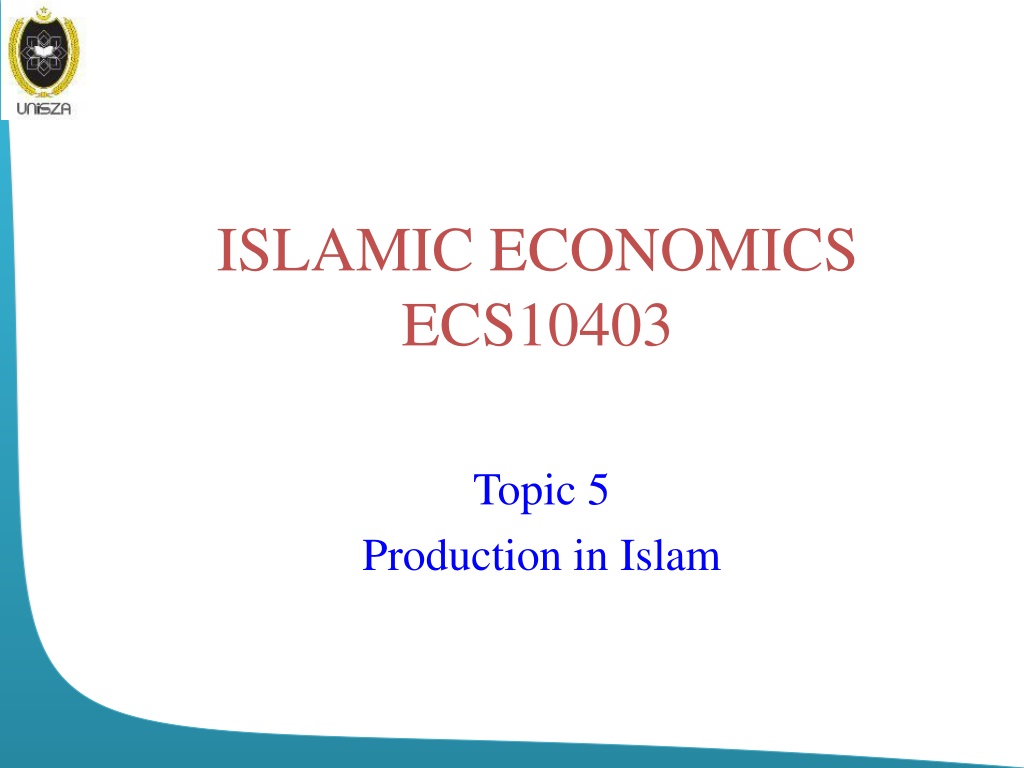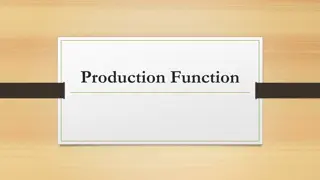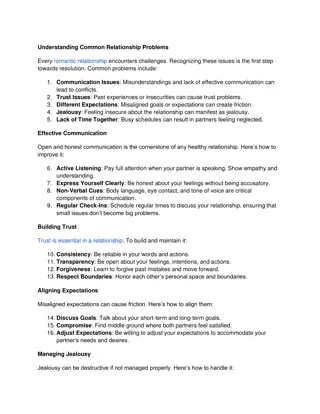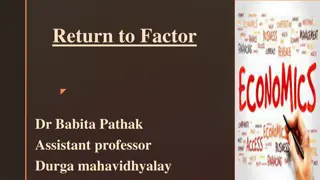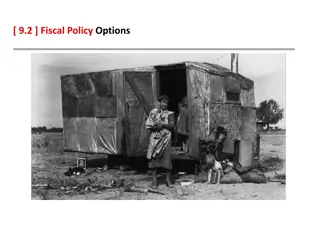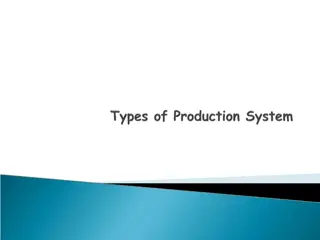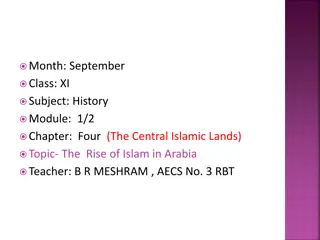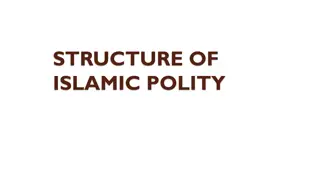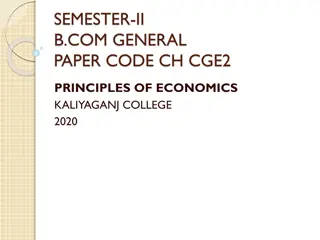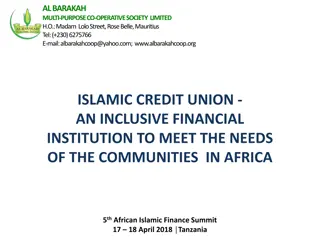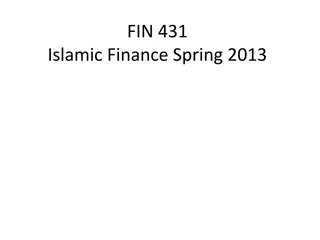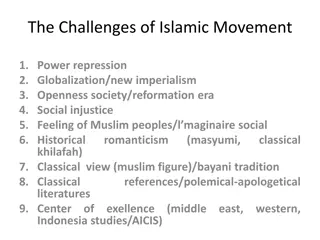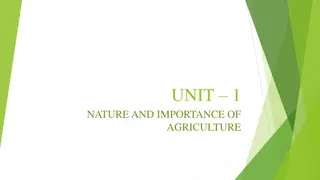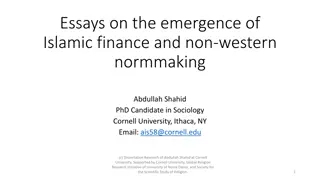Factors of Production in Islamic Economics
This topic delves into the factors of production in Islamic economics, highlighting the importance and organization of production in Islam, al-Ghazali's views on production activities, and the hierarchy involved. Students will explore concepts, goals, and the significance of production, along with the Islamic and secular theories of producer behavior and optimality. The discussion covers resource inputs, such as land, labor, capital, and entrepreneurship, and their role in creating goods and services for economic profit within an Islamic framework.
Download Presentation

Please find below an Image/Link to download the presentation.
The content on the website is provided AS IS for your information and personal use only. It may not be sold, licensed, or shared on other websites without obtaining consent from the author.If you encounter any issues during the download, it is possible that the publisher has removed the file from their server.
You are allowed to download the files provided on this website for personal or commercial use, subject to the condition that they are used lawfully. All files are the property of their respective owners.
The content on the website is provided AS IS for your information and personal use only. It may not be sold, licensed, or shared on other websites without obtaining consent from the author.
E N D
Presentation Transcript
ISLAMIC ECONOMICS ECS10403 Topic 5 Production in Islam
LEARNING OUTCOMES In this topic students will know the following, Factors of Production and Islamic Economics. The importance and organization of production and production behaviour in Islam. Views of al-Ghazali on production activities and hierarchy. 2
CONTENTS Factors of production Concepts, goals and importance of production in Islam Hierarchy of production in Islam Islamic and secular theory of producer behaviour and optimality. Secular and Islamic organization of production and business Factor market equilibrium 3
DEFINITION OF PRODUCTION The processes and methods used to transform tangible inputs (raw materials, semi-finished goods, subassemblies) and intangible inputs (ideas, information, knowledge) into goods or services. Resources are used in this process to create an output that is suitable for use or has exchange value. 4
DEFINITION OF FOP Factors of production refer to an economic term to describe the inputs that are used in the production of goods or services in the attempt to make an economic profit. The factors of production include land, labor, capital and entrepreneurship. 5
ECONOMIC RESOURCE AND RESOURCE PAYMENTS SECULAR RESOURCE PAYMENT ISLAMIC RESOURCE PAYMENT CONVENTIONAL ECONOMIC RESOURCE ISLAMIC ECONOMIC RESOURCE HIRED FACTORS OF PRODUCTION: land, animals, human resources (skilled & unskilled labour), buildings, other goods for usufruct LAND: natural resources RENT UJRAH (WAGES OR RENT) LABOUR: skilled & unskilled labour WAGES CAPITAL: man-made resources (machines, buildings, equipment) ENTREPRENEURIAL ABILITY: human resources that combine land, labour & capital - organizes and produces output ENTREPRENEURIAL FACTORS OF PRODUCTION: combining human resources and non- human resources (physical capital or money) in a productive economic venture INTEREST RIBH (PROFIT) PROFIT 6
CONVENTIONAL RESOURCES AND RESOURCE PAYMENTS Conventional economics does not regard money capital as a separate factor of production, but recognizes interest as the reward for capital. The interest rate is regarded as the price of money capital but is treated as representing also the price of physical capital. Even land and rental may be priced at interest as a trade-off between a fixed return from financial assets (such as fixed deposits or government bonds): P = R / r, if rental is $1000 and interest is 10%, the P = 1000 / 0.1 = 10,000. In secular theory, money is deemed a commodity that can be traded in the money market and rented out at interest; but in Islam money cannot be rented. In Islam, money is an instrument of transfer only, and the financial market for capital for monetary resources is a real sector and not just a money-market. 7
ISLAMIC FRAMEWORK FOR FACTORS OF PRODUCTION In an Islamic framework, factors of production can be identified according to their functions; Hired factors of production (HFP) that provide a productive service for which they are entitled to receive a definite reward (wages or rent) Entrepreneurial factors of production (EFP) that choose to bear the risk of an entrepreneurial project rather than receive a fixed wage or rent HFPs are derived from resources which could also offer themselves as EFPs. The supply & demand for HFPs thus competes with the supply and demand for EFPs. All resources have to opt for HFP and ujrah or EFP and ribh. Money cannot be an HFP but can serve as an EFP if it bears risk; EFP implicitly recognizes money in the Islamic economic system as a factor or production to the extent that it is capable of bearing risk and entitled to profit as with physical capital and human resources (labour). 8
ISLAMIC FACTOR MARKETS Factor markets: theories of the supply and demand of labour and capital in Islam are not dramatically different from conventional economics, except; The rental of capital goods on ijarah should be on the basis of operating leases not financial leases, real rental is the price of a real service not pegged to an interest rate. Marginal productivity will determine the demand for human resources and physical capital to be employed on an ujrah basis. The supply of capital is not a function of savings and a choice between present or future consumption, and so has no link with an interest rate, but rather the supply of capital is determined by the opportunity cost of producing capital goods. 9
THE KHALIFAHS RESPONSIBILITIES IN THE PROCESS OF PRODUCTION Man is encouraged to work very hard and to utilise these resources in the best way and at the same time to express the gratitude of Allah (s.w.t.) Islam has discouraged man from depending on others in order to fulfil his needs. Khalifah s responsibilities towards production in terms of utilising natural resources as labour, as the owner of the capital and as the entrepreneur. 10
KHALIFAHS RESPONSIBILITIES TOWARDS NATURAL RESOURCES Natural resources includes land, water, minerals, mines and forests, etc., which have been given by Allah (s.w.t.) to his khalifah as a TRUST. The khalifah has to utilise these resources in the best way to satisfy his needs and at the same time he must be conscious that he is held ACCOUNTABLE for any misuse of these resources. And do they not see that We do drive rain to parched soil (bare of herbage), and produce therewith crops, providing food for their cattle and themselves? Will they not then see? (As-Sajda, 32:27) 11
IMPORTANCE OF UTILIZING IDLE LAND The Sunnah also provides ample evidences encouraging man to cultivate idle land as highlighted in the following hadith; Narrated 'Aisha: The Prophet said, "He who cultivates land that does not belong to anybody is more rightful (to own it). (Bukhari, 3:528) This means that idle land, which has been left uncultivated for a long period, (according to Muslim scholars 5 years), then its ownership must be transferred to anyone who cultivates it. 12
KHALIFAHS RESPONSIBILITY IN TERMS OF LABOUR From the Islamic perspective, man has been created to struggle and work hard in order to obtain his living, this has been highlighted in a number of ayat, for example: Verily We have created man in toil. (Al-Balad, 90:4) Then when the (Jumu'ah) Sal t (prayer) is finished, you may disperse through the land, and seek the Bounty of All h (by working, etc.), and remember All h much, that you may be successful. (Jumu ah, 62:10) 13
KHALIFAHS RESPONSIBILITY AS THE OWNER OF THE CAPITAL AND AS AN ENTREPRENEUR Islam recognises the great importance of capitalin human life as highlighted in the following ayat: Fair in the eyes of men is the love of things they covet: Women and sons; Heaped-up hoards of gold and silver; horses branded (for blood and excellence); and (wealth of) cattle and well-tilled land. Such are the possessions of worldly life; but Allah has with Him the best return (i.e. Paradise). (Al-'Imran, 3:14) 14
KHALIFAHS RESPONSIBILITY AS THE OWNER OF THE CAPITAL AND AS AN ENTREPRENEUR (Cont.) Moreover, from Islamic point of view, both the owner of the capital and the Muslim entrepreneur are the khalifahs who should see business as part of worship (ibadah) or good deed and at the same time to bear the risk of profit and loss in production or in the business venture. 15
PRODUCTION IN AN ISLAMIC SOCIETY Islam stipulates and encourages tijarat kasb al-halal, (lawful trade) in other words Islam recommends certain norms of behaviour in the market while seeking profit. Islam has discouraged any entrepreneur to borrow at interest, and at the same time has encouraged business through trade. Islam has recommended the khalifah to observe certain norms of behaviour while dealing in business transactions. 16
HIERARCHY OF PRODUCTION AND PRODUCTION ACTIVITIES Imam Ghazali commented on the various kinds of production activities, including their hierarchy. He considers economic pursuits as part of an individual s worship (Ihya, 2:61), and the production of necessities as a socially obligatory duty (Ihya, 2:83). The State must assume responsibility to ensure that necessities are produced in sufficient quantities. He classifies a hierarchy of primary (agriculture), secondary (manufacturing) and tertiary (services) production activities into three broad groups (Ihya, 1:12,13,16); Basic industries: important to sustain life - agriculture (food); textiles (clothing); construction (shelter) and infrastructure to facilitate production of necessities. Ancillary activities: basic industries - iron industry; mineral extraction; forestry resources. Complimentary activities to basic industries, such as the grinding and baking of agricultural products. 17
STATE ENCOURAGEMENT OF PRODUCTION AND PRODUCTIVITY Early precedents of economic activities and the state involve the state extending financial help to farmers to encourage production and productivity; Yahya reported that Umar II wrote, Look into the the state lands in your province and distribute them on the condition of share-cropping at half of the yield or even less, reducing the state s share to one tenth. However, if the land is so infertile that nobody likes to cultivate it even at one tenth, give it for nothing. If even then there is nobody to accept it, spend on its cultivation from the public treasury so that no land under your control is neglected. (Yahya, 1979:63). Abu Ubayd reported that Umar II ordered one of his governors to extend loans to the farmers for the development of land (Abu Ubayd, 1986:265) 18
SECULAR THEORY OF PRODUCER BEHAVIOUR Profit Maximization: for producers, the economic problem is to maximize profits. The key decisions are which outputs to produce, how much of each output to produce, and which inputs to use to produce the outputs. The indifference curve solves the utility-maximizing problem of consumers, and in a firm that is maximizing profit, the production isoquant also deals with the cost-minimization problem of producers, revealing the technological tradeoff between capital and labor in the production function, and the decreasing marginal returns of both inputs. Adding one input while holding the other constant eventually leads to decreasing marginal output, and this is reflected in the shape of the isoquant. The production function is an engineering relation that defines the maximum output (Q) from a given set of inputs, namely capital (K) and labour (L): Q = f (K, L). 19
SECULAR UTILITY THEORY OF VALUE ALSO APPLIES TO PRODUCTION Optimality with the production isoquant, reveals the ability of the firm to substitute two different inputs (e.g. labour & capital) in order to produce the same level of output Q. The optimal marginal rate of technical substitution is where the isoquant is tangent with the isocost curve ( iso in Greek means equal ). 20
SECULAR PROFIT MAXIMIZATION For a purely competitive firm, the firm compares what each additional unit of output would add to TR and TC, i.e. the firm compares MR to MC. In the short run the firm will maximize profit where the demand schedule (d) is perfectly elastic since the firms is a price-taker and equals MR (= P) = MC, and MC is the short run supply curve or the Q of output at each price. The sum of 1000 individual supply curves (s) determines industry supply curve (S), and given industry D, the short run equilibrium P and Q are $111 and 8000 units. 21
OPTIMALITY Optimality also applies to the production possibilities curve, which reveals optimal efficiency including output, revenue and profit. In terms of resource allocation, Pareto-optimality, defined as an attained optimal point that cannot be changed without making anyone worse off, results in competition between alternatives: not only competing goods, labour and capital, but competing social groups, political opponents, even competing fiscal and monetary policies. However, Islam demands a certain type of behaviour from producers (and consumers). 22
PRODUCER BEHAVIOUR IN ISLAM Muslims are bound by Islamic ethics and morals in the market place. Conventional producers seek profit maximization, while Islamic producer engages in profit sharing and a reasonable profit Producers must not produce unlawful products or activities. Producers must spend part of their wealth to the less fortunate members in the Islamic society. 23
ENTREPRENEUR AND PRODUCTION IN ISLAM As a private merchant, the khalifah is the entrepreneur and bears the risk of profit or loss. As a partner, the entrepreneur can trade under two major forms of business, being contractual partnership (sharikat al-`aqd): mudharabah and musharakah. In each case, general principles of factor pricing and income distribution will be applied in the ex ante (before the event) determination of the share of capital and entrepreneurship. Ibn Qudamah said, it is not permissible to guarantee for any partner a pre-specified number of dirhams. If one partner's profit amount is specified in dirhams, or if a specified increment over his profit-share is pre-specified, the partnership is thus invalidated (Al-Mughni). 24
MUDHARABAH BUSINESS In this case the khalifah is the owner of the capital (rabb al-mal) and gives his property to another khalifah, the entrepreneur (mudarib), to manage the business, and each will have an agreed share of the profit. In case there is a loss, the owner of the capital will bear the loss and the mudarib will lose his time and effort. The ex ante (before the event) determination of the share capital in the case of mudharabah will be determined by the interaction of the demand for (Dk) and supply of capital (Sk). 25
EX-ANTE DETERMINATION OF PROFIT- SHARES IN MUDHARABAH Prices (profit shares) of capital and entrepreneurship in percentage terms are measured along the left and right vertical axes, and the amount of capital along the horizontal axis. Sk is upward sloping implying that the quantity of capital supplied increases as the capital provider s profit-share increases. Dk is downward sloping implying that the quantity of capital demanded increases as the capital provider s profit-share decreases. Sk and Dk intersect at T, determines the profit-share ratio: e.g. 60:40 The risk of losses are incurred by the capital provider and the entrepreneur s service will go unrewarded. Source: Sadeq, 1990:54 26
MUSHARAKAH BUSINESS In this case two or more partners (khalifahs) combine their capital in a business. They jointly manage their business and they jointly bear the risk of profit and loss in a pre-agreed proportion. The loss is apportioned according the ratio of capital contributed by each partner, and the profit is distributed according to a pre-agreed ratio by mutual consent. The ex-ante determination of profit & loss sharing for musharakah are based on factor pricing of capital and entrepreneurship that is based on justice. The income distribution for musharakah and mudharabah are equitable, because each partner receives a share in the profit on the basis of the partner s contribution to the production process. 27
EX-ANTE DETERMINATION OF PROFIT-SHARES IN MUSHARAKAH Upper & lower horizontal axes represent capital provided by A & B, whilst left & right axes depict their respective profit-shares. If Shafi i or Maliki, partners should share in profits according to their respective contribution of capital, given by Oa-R-Ob, assuming A contributes 25% of the capital and thus A receives 25% of the profit. If Hanafi or Hanbali, partners may vary their profit share reflecting entrepreneurial ability, e.g. either Oa-N-Ob or Oa-M-Ob. The distribution of any losses are based on the share of capital contributed, because the share of entrepreneurial services will go unrewarded. For losses Oa-R-Ob would thus apply. Source: Sadeq, 1990:56 28
GROWTH AND CAPITAL IN AN ISLAMIC ECONOMY Clearly, the Islamic economic system encourages and facilitates the mobilization of the factors of production necessary for economic growth. Natural resources are made available in abundance for man to explore and use them for the production of goods and services to meet man s needs including moral and social obligations. The optimal use of human resources and hard work is necessary to produce goods and services in order to meet limited needs. But Islam does not undermine capital (like socialism) nor pay capital nominal interest out of net revenues (like capitalism), but recognizes the importance of capital in the production process, through a pre- determined percentage of profits (or losses). Risk and rewards are shared by capital providers and entrepreneurs: the provision of Islamic finance is by default entrepreneurial. The system of sharing profits (or losses) has the potential to increase investment up to the level at which marginal profit is zero (Sadeq, 1990:6-7) 29
INVESTMENT POTENTIAL OF AN ISLAMIC ECONOMY AB = marginal profits (gross sales revenues of successive investments minus all costs other than payments to capital), which diminish as investment increases. BC = subtracting vertically from AB a fixed percentage share of marginal profits payable to the capital provider (AB-BC) and the balance is retained by the entrepreneur (OB-BC). In a capitalist economy, investment will occur up to O-Io at an interest rate O-Ro as losses will occur since each additional unit of investment adds more to cost than profit. In an Islamic economy, investment continues up to O-I1, as each additional investment adds profit to both entrepreneurs and capital providers. Source: Sadeq, 1990:7 30
EFFICIENCY OF RESOURCE ALLOCATION IN AN ISLAMIC ECONOMY As per the following table, investment can be carried out by the entrepreneur to the fullest potential in an Islamic economy. For example, assuming the pre-determined profit-sharing ratio is 60:40 between the entrepreneur (mudarib) and capital provider (rabb al-mal). If capital is borrowed from a conventional bank at an interest rate of $10 per $1000 per project period, of say 3 months (short-term trading). An entrepreneur can invest up to $9000 since the marginal efficiency of capital equals the interest payment: at this level of investment, the additional $1000 of invested capital generates $10 in profit but he has to pay $10 in interest. The borrowed capital costs a total of $90 in interest, with profits after interest payment of $595 - $90 = $505 If he invests $8000, the profit after interest is also $585 - $80 = $505, therefore the lower investment is less risky. The Islamic entrepreneur will continue investing capital up to $13000 since he continues to receive positive profits, an may even invest $14000 without further risk to himself even when the net gain is zero (Sadeq, 1990:6-7) 31
EFFICIENCY OF RESOURCE ALLOCATION IN AN ISLAMIC ECONOMY Source: Sadeq, 1990:22 Investment and in turn employment is expected to be higher in an Islamic economy. 32
FACTOR MARKET EQUILIBRIUM FROM ISLAMIC PERSPECTIVE From Islamic perspective factor pricing inputs depend on the type of responsibility which had been accomplished by the khalifah. Hence, it can be classified into three categories as follows: Production with a Cost Production with a Minimum Cost Voluntary Production 33
PRODUCTION WITH A COST In this case the khalifah will be paid for all his responsibilities in the process of production. If the khalifah is the owner of the land then he will receive rent or ujrah for the usage of his land. If he is a worker (labour) then payment in term of wages will be given to him for his time and effort. And in the case of a firm, where both the owner of the capital and the entrepreneur will be involved, then both khalifahs will be exposed to the risk of profit sharing or loss. 34
PRODUCTION WITH A MINIMUM COST In this case some of the factors of production are used voluntarily, i.e. without any cost Land has been given free for certain duration or; Labour has been involved voluntarily, or; Entrepreneur advice given free, or; Capital is given free for certain duration. 35
VOLUNTARILY PRODUCTION In this case the khalifah can contribute voluntarily with his capital or efforts to generate certain business, without payment, that can benefit the society at large: Land has been given free for certain duration or upon certain conditions as a grant ( iqta), and; Labour has been involved voluntarily, and; Entrepreneur advice given free, and; Capital is given free for certain duration. Moreover, the voluntary responsibility of the khalifah brings him closer to Allah (s.w.t.) by virtue of one s righteous deeds. In this case the khalifah succeeds in helping society at large and at the same time seeks the reward in the hereafter 36
MULTIPLICATION OF REWARDS FOR VOLUNTARY ACTIVITIES The likeness of those who spend their wealth in the Way of All h, is as the likeness of a grain (of corn); it grows seven ears, and each ear has a hundred grains. All h gives manifold increase to whom He pleases. And All h is All-Sufficient for His creatures' needs, All-Knower. (Al-Baqarah, 2:261) 37
INCLUDING THE ROLE OF THE KHALIFAH TOWARDS HIS/HER RESPONSIBILITY TO THE SOCIETY IN A COMPETITIVE MARKET THE PRICE WILL BE FIXED AT P1 AND THE QUANTITY D&S WILL BE AT Q1 Price D S1 S2 P1 S3 P2 P3 Q1 Q2 Q3 Quantity 38
